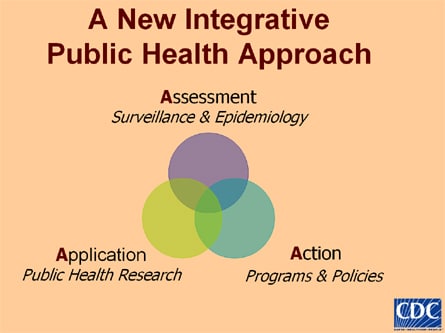Public Health Approach
 A Public Health Approach to Vision Loss
A Public Health Approach to Vision Loss

The Vision Health Initiative employs a distinctive public health approach to address vision through three key activities: assessment (surveillance and epidemiology), application (applied public health research), and action (integrating vision health into programs and policy).
Assessment: of the Burden of Vision Loss and Eye Diseases
To better understand and plan for the vision care need, there is a critical need for national- and state-level vision and eye health data from representative U.S. populations, including data from minority groups and high-risk populations. Data on vision loss among children as well as vision loss related to occupational and recreational injuries are extremely scarce and need to be strengthened. CDC uses surveys such as the Behavioral Risk Factor Surveillance System (BRFSS), National Health and Nutrition Examination Survey (NHANES), and the National Health Interview Survey (NHIS) to assess the burden of vision loss, quality of life, quality of care, population and prevalence estimates, comorbid conditions and their effects, and to monitor trends. CDC/VHI specific activities include the following:
Assessing the role of available data sources for measuring and monitoring vision loss and eye diseases.
- Assessing the impact of blindness and vision impairment through the lifespan.
- Building capacity to conduct epidemiologic, behavioral, health services, and economic research related to vision loss and eye diseases at all stages of life.
- Exploring innovative mechanisms to collect data, including administrative data and electronic medical records.
- Identifying populations most at risk for vision loss.
- Identifying populations with vision loss most at risk of health disparities.
- Improving current vision loss and eye diseases data collection, including consensus of case definition of vision loss in surveys and validity of self-reporting methods.
- Strengthening vision surveillance at the state level through the Visual Impairment and Access to Eye Care Module of the Behavioral Risk Factors Surveillance System (BRFSS).
- Strengthening vision surveillance at the national level by supporting the eye evaluation component of the National Health and Nutrition Examination Survey.
Application: Applied Public Health Research
CDC/VHI uses the knowledge gained from epidemiology, surveillance, economic concept, and health services research to conduct applied public health research to understand the consequences and costs of vision loss as well as to develop evidence- based, cost-effective interventions to address the problem.
Economic studies estimate the cost of vision loss and eye diseases to individuals and their families as well as to extended family care-givers and third party payers, the health care system, and society. Intervention effectiveness studies evaluate the evidence, efficacy, and cost-effectiveness of prevention and treatment interventions. Behavioral and systems research increase understanding of barriers and facilitators to access and use vision care services. Other CDC/VHI activities include the following:
- Assessing the effects of vision loss on labor market participation, health, and health behaviors.
- Increasing the understanding of access and use of vision care services.
- Estimating the cost of vision loss and eye diseases to individuals and their families as well as to extended family caregivers, insurance, health care system, and society.
- Evaluating the impact of vision loss and eye diseases on individual’s and caregivers’ quality of life.
- Evaluating the application of behavior change models to utilization of care and health care provider practice.
Translational research moves scientific evidence into public health practice and health program strategies by identifying, developing, and disseminating evidence-based, cost-effective interventions and strategies to—
- Improve access to eye care.
- Reduce health disparities among high-risk groups, improve overall quality of life
- Promote the health of people who are at risk or experience vision loss.
Action: Programs and Policy
Public health programs aim to prevent diseases and conditions by promoting healthy lifestyles, changing the health system to encourage appropriate provider and patient behaviors, and removing barriers to access to eye care while improving facilitators to access. Programs, policies, and systems should focus their priorities upon all life stages to increase awareness of vision health and vision disorders, prevent unnecessary vision loss, and promote the health of people with vision loss. CDC/VHI’s programs and policy are strengthened by—
- Enhancing the role of existing state and community public health agencies to foster vision health.
- Facilitating strategic partnerships to preserve, protect, and enhance vision health.
- Collaborating with key stakeholders to develop coordinated national public health approaches for people with or at risk for vision loss and blindness to improve health and community participation.
- Integrating vision health into state and national public health practice and policy.
- Integrating vision health into public health systems, national health policy, and standards of care.
- Promoting proven evidence-based, cost-effective interventions in states and communities.
- Recommending health care policies to improve vision health.